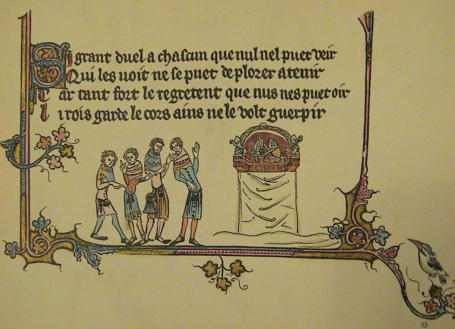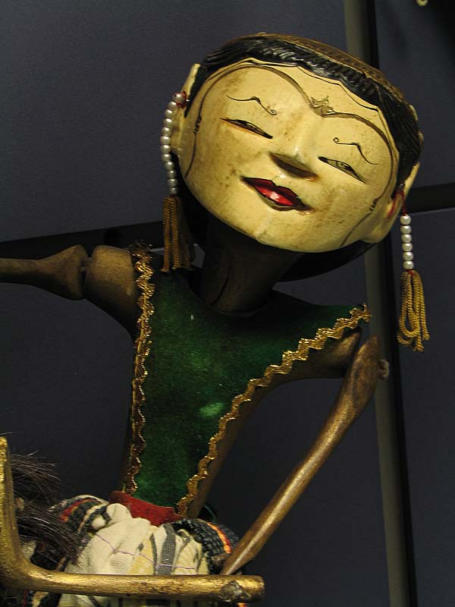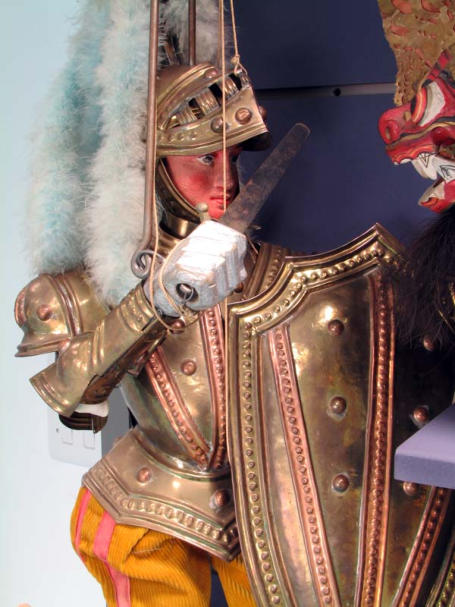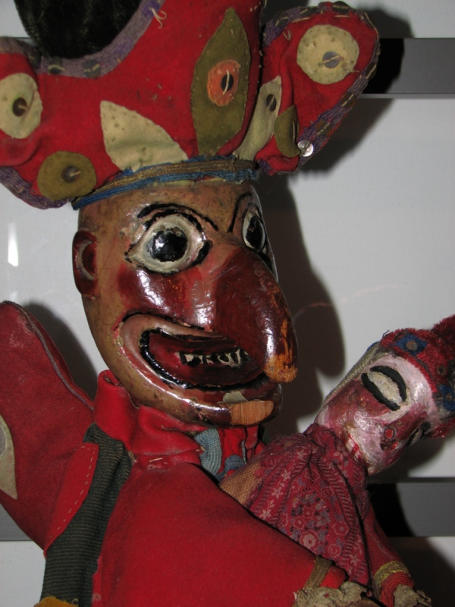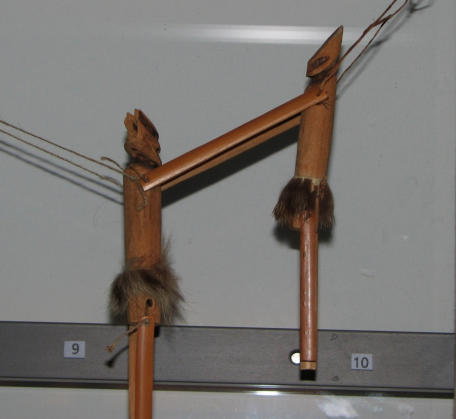NAVIGATION
SOCIAL
CONTACT
e-mail: info@theworldthroughwoodeneyes.co.uk

History
The
London
fairs
of
Bartholomew
and
Southwark
provided
amongst
its
entertainments
a
number
of
puppet
shows,
and
on
their
decline,
and
the
popularity
of
Mr
Punch,
he
departed
elsewhere
in
the
streets
of
London,
where
the
now
familiar
striped,
chimney
stack
shaped
booth
was
seen
with
a
new
wife
and
sequence
of
characters
that
constitute
the
show
that
continues
to
entertain
audiences
as
it
did
in
the
past,
despite
predictions
of
decline,
and
being
politically
incorrect.
It
is
interesting
to
note
that
Samuel
Pepys
first
saw
Mr
Punch,
as
a
string
puppet,
outside
St
Paul’s
Church,
Covent
Garden,
and
recorded
his
reactions
in
his
diaries.
The
18th
and
19th
centuries
are
referred
to
as
the
Golden
Ages
of
European
puppet
theatre,
where
large-scale
artistic
marionette
theatres
proliferated
attracting
many
notable
personalities
from
the
arts
contributing
plays,
and
a
substantial
quantity
of
important
literature
on
the
art.
Many
performances
followed
important
traditional
ideas,
notably
productions
of
Faust,
based
on
Goethe’s
epic
work
of
the
same
name.
These
centuries
also
saw
the
development
of
the
popular
comic
folk
heroes,
with
virtually
every
country
represented
by
a
character
similar
to
Mr
Punch.
French
Polichinelle,
German
Kasper,
Hungarian
Vitez
Laszlo,
Romania’s
Vasilache.
The
Dutch Jan Klaasen, and Russia’s Petrushka to name a few.
Shadow
puppets
also
presented
themselves
in
Egypt,
Greece
and
Turkey
with
the
later
countries
Karagoz
and
Karagiozi
–
Black
eye,
the
central
character.
The
origin
of
these
traditions
are
rooted
in
Indian
sources.
Java,
Bali,
Cambodia,
Thailand
had,
and
still
does
have,
a
strong
tradition
of
shadow
theatre,
from
the
smaller
wayang
kulit's
in
Java
and
Bali,
and
the
larger
Nang
screens
in
Cambodia
and
Thailand.
Java
is
also
known
for
its
three-dimensional
wayang
golek’s,
and
semi-dimensional wayang kulit’s.
Sicily
has
a
unique
tradition
of
puppet
play
with
its
large-scale
figures
with
their
solid
brass
armour
and
iron
rod
controls
to
the
head
and
sword
hand
to
enable
them
to
execute
fierce
battles
where
heads
and
whole
bodies
are
cut
in
two
parts,
all
part
of
the
presentation
of
the
epic
legends
of
Charlemagne.
This
tradition
can
also
be
seen
in
Belgium,
in
Liege,
Antwerp
and
Brussels.
This
tradition
developed
out
of
the
need
for
the
vast
numbers
of
Sicilian
miners
to
swell
the
ranks
of
Belgian
miners.
During
quiet
times,
the
Sicilians
carved
their
large
figures
out
of
pit
props.
The
performances
were
given
in
numerous
inns
and
cellars around Liege and Antwerp.
Puppets
cannot
be
fully
understood
or
effective
within
the
framework
of
a
collection
or
in
a
museum,
but
in
movement
in
a
theatre.
It
is
certain
that
puppets
deserve
their
place
as
works
of
art
that
satisfy
the
highest
critical
artistic
standards,
sadly, the names of the craftspeople who create puppets generally remain anonymous.
The
art
of
the
puppet
theatre
cannot
be
isolated
from
other
forms
of
creative
expression
to
which
they
are
inextricably
linked, such as the fine, and performance arts, folk art, literature, storytelling and music.
Although
conjecture,
knowledge
of
storytelling
techniques,
and
the
work
of
the
shaman
in
the
use
of
their
familiars
in
primitive
culture
it
is
more
than
likely
that
the
cave
dwellers
in
ancient
times
used
hand
shadows
projected
on
cane
walls,
and
simple
puppets
made
of
grasses,
twigs
and
other
materials
were
used
to
dramatise
tales
of
hunts,
battles
and
other domestic happenings.
What
is
certain
is
that
the
puppet
and
the
puppet
play
in
different
forms
has
existed
since
the
earliest
times,
and
fundamental to the development of humankind.
Through
the
ages
puppeteers
have
been
seen
as
vagrants
emerging
from
the
lowest
orders
of
society.
During
the
middle-ages
they
were
frequently
considered
to
be
witches,
wizards
and
magicians,
and
there
is
evidence
of
them
being
burnt at the stake, seen to possess supernatural powers to give inanimate figures life.
Due
to
the
perishable
nature
of
puppets
nothing
exists
from
ancient
times.
There
is
evidence
of
the
existence
of
puppets
in
China
and
India
2500
years
ago.
In
India,
The
Natyasatra,
the
Sanskrit
book
mentions
the
sutradhara
–
holder
of
strings,
and
to
this
day
the
great
epic
poems,
The
Ramayana
and
The
Mahabarata
are
still
performed by shadow, hand and string puppets.
The
puppets
in
China
can
be
traced
to
the
Han
dynasty
206BC
and
a
vast
range
of
puppet
types
and
techniques
are
listed,
water
puppets,
flesh
puppets,
iron
branch
puppets,
some
of
which
are
still
unknown
to
us.
Shadow
puppets
still
exist
in
many
regions
of
China,
and
since
the
Chinese
Revolution
the
skills
in
making
them
have
been
encouraged
to
develop.
The
Shadow
puppets,
generally
made
of
animal
skins,
carefully
carved
and
coloured
and
held
against
a
back
lit
screen
possess
a
magical
quality with their dissolves and vanishing apparitions.
One
of
the
earliest
references
to
the
shadow
puppet
in
China
tells
of
an
emperor,
mourning
the
death
of
his
wife,
summoned
a
shadow
puppeteer
to
conjure
up
her
spirit
and
bring
it
to
him
each
evening.
The
Chinese
shadow
puppet
theatre
continued
its
influence
in
the
18th
and
19th
centuries
in
France
under
the
name
of
The
Ombres
Chinoises,
and
in
England
as
The
Chinese
Shades.
In
Paris,
the
artists
cabaret
The
Chat
Noir
presented
sophisticated
shadow
performances
which
ultimately led to the evolution of the film animation and the cinema.
Africa
is
particularly
rich
in
puppet
traditions
mainly
based
on
ritual
and
cult.
The
performances
using
a
wide
range
of
puppet
techniques
from
the
tiny
Tulukutu,
foot
operated
jigging figures
, to elaborate giant figures incorporating animated masks.
Some
of
the
earliest
existing
puppets
came
from
classical
Greece.
They
are
small
figures
of
terracotta,
bronze
and
wood,
and
it
is
from
this
time
that
we
find
the
word
Neuropasta
–
pictures
moved
by
strings.
Xenophon
and
Athenaeus
mention
puppet
players
in
their
writings
Athenaeus
mentioning
the
first
named
puppeteer
Potheinos
who
performed
in
the
theatre of Dionysus in Athens.
Puppets
are
frequently
linked
to
automata’s,
and
in
the
Middle
Ages
we
find
interesting
references
to
automated
set
pieces
built
over
church
altars.
There
are
rich
resources
from
this
period
that
clearly
indicate
the
popularity
of
the
puppet
shows,
and
their
increasing
extensive
travels
through
Europe
and
into
England.
In
Italy
the
Commedia
dell
Arte
troupes
of
live
performers
spawned
the
character
Pulcinella
whose
popularity
led
to
the
existence
of
a
hand
puppet
show.
Pulcinella
looked
similar
to
the
grotesque
characters
of
the
Greek
and
Roman
theatre.
His
popularity,
and
the
popularity
of
Italian
performers
in
England
led
to
the
evolution
of
our
character
Mr
Punch,
first
as
a
string
puppet,
and
later
as
a
hand
puppet.
His
earlier
exploits
can
be
seen
in
William
Hogarth’s
painting
and
engraving
Southwark
Fair,
where
he
appeared
in
a
series
of
biblical
works such as Adam and Eve, and The Wooden Horse of Troy.
From
the
Middle
Ages
onwards
we
have
many
important
documents
showing
puppets.
One
wood
block
print
from
the
Hortus
Deliciarum,
showing
two
jousting
knights
on
strings
operated
on
a
table
top
by
two
performers.
Later
the
Roman
Du
Bon
Roi
Alexandre
1344
shows
a
small
hand
puppet
booth
known
as
a
castelet
with
two
jousting
figures
as
part
of
a
fine
illustrated
manuscript,
now
in
the
Bodleian
Library, Oxford.
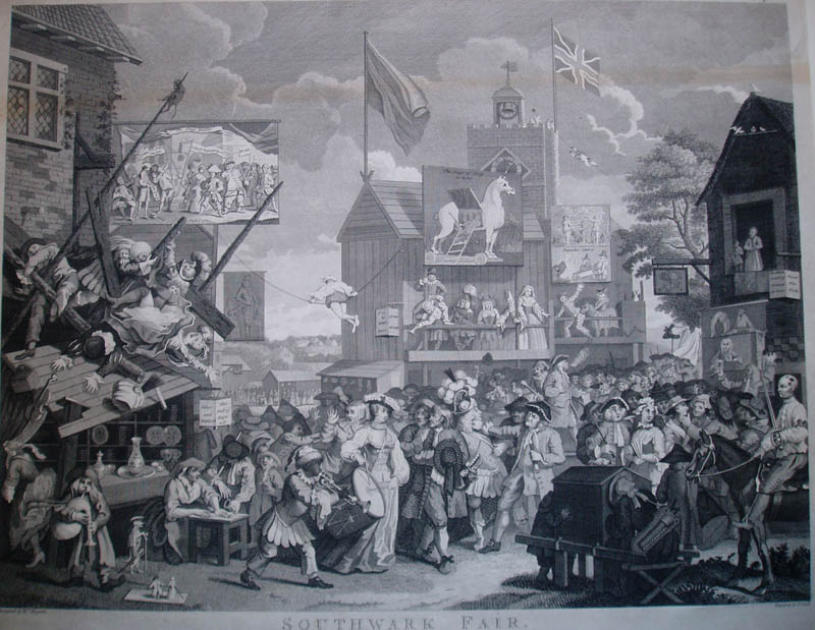

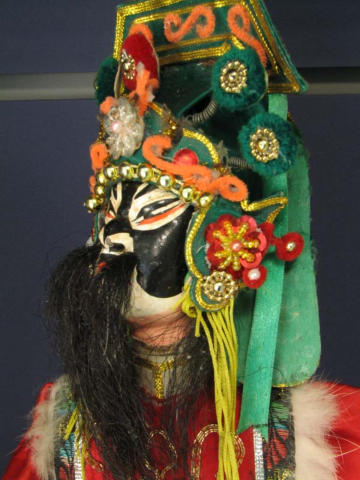


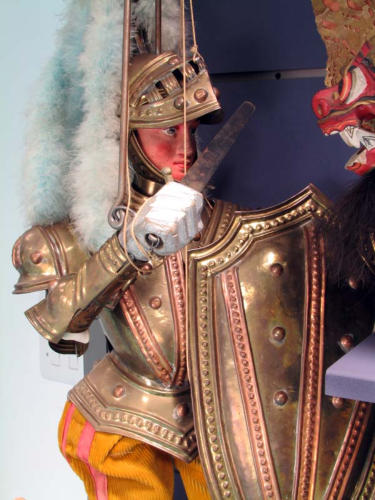

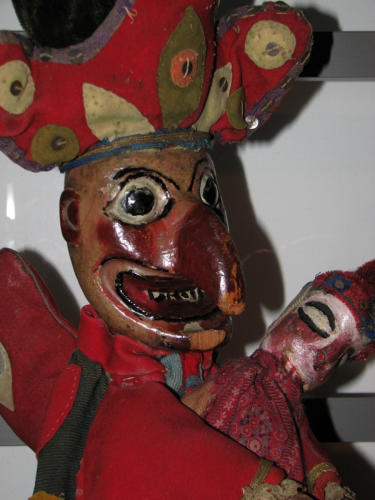
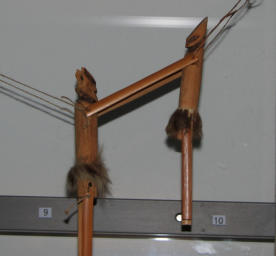

CONTACT
e-mail: info@theworldthroughwoodeneyes.co.uk
SOCIAL

history
Puppets
cannot
be
fully
understood
or
effective
within
the
framework
of
a
collection
or
in
a
museum,
but
in
movement
in
a
theatre.
It
is
certain
that
puppets
deserve
their
place
as
works
of
art
that
satisfy
the
highest
critical
artistic
standards,
sadly,
the
names
of
the
craftspeople
who
create
puppets generally remain anonymous.
The
art
of
the
puppet
theatre
cannot
be
isolated
from
other
forms
of
creative
expression
to
which
they
are
inextricably
linked,
such
as
the
fine,
and
performance
arts,
folk
art,
literature,
storytelling
and
music.
Although
conjecture,
knowledge
of
storytelling
techniques,
and
the
work
of
the
shaman
in
the
use
of
their
familiars
in
primitive
culture
it
is
more
than
likely
that
the
cave
dwellers
in
ancient
times
used
hand
shadows
projected
on
cane
walls,
and
simple
puppets
made
of
grasses,
twigs
and
other
materials
were
used
to
dramatise
tales
of
hunts,
battles
and
other
domestic
happenings.
What
is
certain
is
that
the
puppet
and
the
puppet
play
in
different
forms
has
existed
since
the
earliest
times,
and
fundamental
to
the development of humankind.
Through
the
ages
puppeteers
have
been
seen
as
vagrants
emerging
from
the
lowest
orders
of
society.
During
the
middle-ages
they
were
frequently
considered
to
be
witches,
wizards
and
magicians,
and
there
is
evidence
of
them
being
burnt
at
the
stake,
seen
to
possess
supernatural
powers
to
give
inanimate figures life.
Due
to
the
perishable
nature
of
puppets
nothing
exists
from
ancient
times.
There
is
evidence
of
the
existence
of
puppets
in
China
and
India
2500
years
ago.
In
India,
The
Natyasatra,
the
Sanskrit
book
mentions
the
sutradhara
–
holder
of
strings,
and
to
this
day
the
great
epic
poems,
The
Ramayana
and
The
Mahabarata
are
still
performed
by
shadow,
hand
and
string
puppets.
The
puppets
in
China
can
be
traced
to
the
Han
dynasty
206BC
and
a
vast
range
of
puppet
types
and
techniques
are
listed,
water
puppets,
flesh
puppets,
iron
branch
puppets,
some
of
which
are
still
unknown
to
us.
Shadow
puppets
still
exist
in
many
regions
of
China,
and
since
the
Chinese
Revolution
the
skills
in
making
them
have
been
encouraged
to
develop.
The
Shadow
puppets,
generally
made
of
animal
skins,
carefully
carved
and
coloured
and
held
against
a
back
lit
screen
possess
a
magical
quality
with
their
dissolves
and
vanishing
apparitions.
One
of
the
earliest
references
to
the
shadow
puppet
in
China
tells
of
an
emperor,
mourning
the
death
of
his
wife,
summoned
a
shadow
puppeteer
to
conjure
up
her
spirit
and
bring
it
to
him
each
evening.
The
Chinese
shadow
puppet
theatre
continued
its
influence
in
the
18th
and
19th
centuries
in
France
under
the
name
of
The
Ombres
Chinoises,
and
in
England
as
The
Chinese
Shades.
In
Paris,
the
artists
cabaret
The
Chat
Noir
presented
sophisticated
shadow
performances
which
ultimately
led
to
the
evolution
of
the
film
animation
and
the
cinema.
Africa
is
particularly
rich
in
puppet
traditions
mainly
based
on
ritual
and
cult.
The
performances
using
a
wide
range
of
puppet
techniques
from
the
tiny
Tulukutu,
foot
operated
jigging
figures
,
to
elaborate
giant
figures incorporating animated masks.
Some
of
the
earliest
existing
puppets
came
from
classical
Greece.
They
are
small
figures
of
terracotta,
bronze
and
wood,
and
it
is
from
this
time
that
we
find
the
word
Neuropasta
–
pictures
moved
by
strings.
Xenophon
and
Athenaeus
mention
puppet
players
in
their
writings
Athenaeus
mentioning
the
first
named
puppeteer
Potheinos
who
performed
in
the
theatre
of
Dionysus in Athens.
From
the
Middle
Ages
onwards
we
have
many
important
documents
showing
puppets.
One
wood
block
print
from
the
Hortus
Deliciarum,
showing
two
jousting
knights
on
strings
operated
on
a
table
top
by
two
performers.
Later
the
Roman
Du
Bon
Roi
Alexandre
1344
shows
a
small
hand
puppet
booth
known
as
a
castelet
with
two
jousting
figures
as
part
of
a
fine
illustrated
manuscript,
now
in
the
Bodleian
Library,
Oxford.
Puppets
are
frequently
linked
to
automata’s,
and
in
the
Middle
Ages
we
find
interesting
references
to
automated
set
pieces
built
over
church
altars.
There
are
rich
resources
from
this
period
that
clearly
indicate
the
popularity
of
the
puppet
shows,
and
their
increasing
extensive
travels
through
Europe
and
into
England.
In
Italy
the
Commedia
dell
Arte
troupes
of
live
performers
spawned
the
character
Pulcinella
whose
popularity
led
to
the
existence
of
a
hand
puppet
show.
Pulcinella
looked
similar
to
the
grotesque
characters
of
the
Greek
and
Roman
theatre.
His
popularity,
and
the
popularity
of
Italian
performers
in
England
led
to
the
evolution
of
our
character
Mr
Punch,
first
as
a
string
puppet,
and
later
as
a
hand
puppet.
His
earlier
exploits
can
be
seen
in
William
Hogarth’s
painting
and
engraving
Southwark
Fair,
where
he
appeared
in
a
series
of
biblical
works
such
as
Adam
and
Eve,
and
The
Wooden Horse of Troy.
The
London
fairs
of
Bartholomew
and
Southwark
provided
amongst
its
entertainments
a
number
of
puppet
shows,
and
on
their
decline,
and
the
popularity
of
Mr
Punch,
he
departed
elsewhere
in
the
streets
of
London,
where
the
now
familiar
striped,
chimney
stack
shaped
booth
was
seen
with
a
new
wife
and
sequence
of
characters
that
constitute
the
show
that
continues
to
entertain
audiences
as
it
did
in
the
past,
despite
predictions
of
decline,
and
being
politically
incorrect.
It
is
interesting
to
note
that
Samuel
Pepys
first
saw
Mr
Punch,
as
a
string
puppet,
outside
St
Paul’s
Church,
Covent
Garden,
and
recorded
his
reactions
in his diaries.
The
18th
and
19th
centuries
are
referred
to
as
the
Golden
Ages
of
European
puppet
theatre,
where
large-scale
artistic
marionette
theatres
proliferated
attracting
many
notable
personalities
from
the
arts
contributing
plays,
and
a
substantial
quantity
of
important
literature
on
the
art.
Many
performances
followed
important
traditional
ideas,
notably
productions
of
Faust,
based
on
Goethe’s
epic
work
of
the
same
name.
These
centuries
also
saw
the
development
of
the
popular
comic
folk
heroes,
with
virtually
every
country
represented
by
a
character
similar
to
Mr
Punch.
French
Polichinelle,
German
Kasper,
Hungarian
Vitez
Laszlo,
Romania’s
Vasilache.
The
Dutch
Jan
Klaasen,
and
Russia’s
Petrushka to name a few.
Shadow
puppets
also
presented
themselves
in
Egypt,
Greece
and
Turkey
with
the
later
countries
Karagoz
and
Karagiozi
–
Black
eye,
the
central
character.
The
origin
of
these
traditions
are
rooted
in
Indian
sources.
Java,
Bali,
Cambodia,
Thailand
had,
and
still
does
have,
a
strong
tradition
of
shadow
theatre,
from
the
smaller
wayang
kulit's
in
Java
and
Bali,
and
the
larger
Nang
screens
in
Cambodia
and
Thailand.
Java
is
also
known
for
its
three-dimensional
wayang
golek’s,
and semi-dimensional wayang kulit’s.
Sicily
has
a
unique
tradition
of
puppet
play
with
its
large-scale
figures
with
their
solid
brass
armour
and
iron
rod
controls
to
the
head
and
sword
hand
to
enable
them
to
execute
fierce
battles
where
heads
and
whole
bodies
are
cut
in
two
parts,
all
part
of
the
presentation
of
the
epic
legends
of
Charlemagne.
This
tradition
can
also
be
seen
in
Belgium,
in
Liege,
Antwerp
and
Brussels.
This
tradition
developed
out
of
the
need
for
the
vast
numbers
of
Sicilian
miners
to
swell
the
ranks
of
Belgian
miners.
During
quiet
times,
the
Sicilians
carved
their
large
figures
out
of
pit
props.
The
performances
were
given
in
numerous
inns
and
cellars
around Liege and Antwerp.

